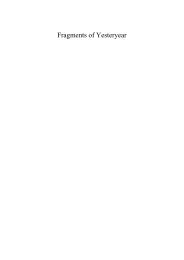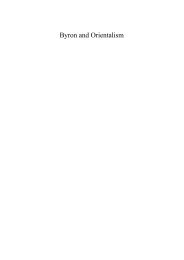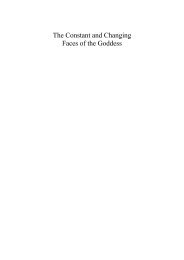Emma di Resburgo, Margherita d'Anjou - Cambridge Scholars ...
Emma di Resburgo, Margherita d'Anjou - Cambridge Scholars ...
Emma di Resburgo, Margherita d'Anjou - Cambridge Scholars ...
Create successful ePaper yourself
Turn your PDF publications into a flip-book with our unique Google optimized e-Paper software.
Giacomo Meyerbeer<br />
The Complete Libretti<br />
in Eleven Volumes<br />
(in the Original and in English<br />
Translations by Richard Arsenty with<br />
Introductions by Robert Ignatius Letellier)<br />
Volume 3
The Meyerbeer Libretti<br />
Italian Operas 2<br />
(<strong>Emma</strong> <strong>di</strong> <strong>Resburgo</strong>, <strong>Margherita</strong> d’Anjou)<br />
E<strong>di</strong>ted by<br />
Richard Arsenty (translations)<br />
and Robert Letellier (introductions)<br />
<strong>Cambridge</strong> <strong>Scholars</strong> Publishing
The Meyerbeer Libretti: Italian Operas 2 (<strong>Emma</strong> <strong>di</strong> <strong>Resburgo</strong>, <strong>Margherita</strong> d’Anjou),<br />
E<strong>di</strong>ted by Richard Arsenty (translations) and Robert Letellier (introductions)<br />
This book first published 2004 as part of The Complete Libretti of Giacomo Meyerbeer in Five<br />
Volumes. This second e<strong>di</strong>tion first published 2008.<br />
<strong>Cambridge</strong> <strong>Scholars</strong> Publishing<br />
12 Back Chapman Street, Newcastle upon Tyne, NE6 2XX, UK<br />
British Library Cataloguing in Publication Data<br />
A catalogue record for this book is available from the British Library<br />
Copyright © 2008 by Richard Arsenty (translations) and Robert Letellier (introductions)<br />
All rights for this book reserved. No part of this book may be reproduced, stored in a retrieval system,<br />
or transmitted, in any form or by any means, electronic, mechanical, photocopying, recor<strong>di</strong>ng or<br />
otherwise, without the prior permission of the copyright owner.<br />
ISBN (10): 1-84718-963-6, ISBN (13): 9781847189639<br />
As the eleven-volume set: ISBN (10): 1-84718-971-7, ISBN (13): 9781847189714
Giacomo Meyerbeer. Lithograph by Pierre Roche Vigneron (c. 1825)
TABLE OF CONTENTS<br />
Preface........................................................................................................ ix<br />
Introduction ................................................................................................ xi<br />
The Libretti:<br />
<strong>Emma</strong> <strong>di</strong> <strong>Resburgo</strong> ...................................................................................... 1<br />
<strong>Margherita</strong> d’Anjou................................................................................. 119
PREFACE<br />
Giacomo Meyerbeer, one of the most important and influential opera<br />
composers of the nineteenth century, enjoyed a fame during his lifetime<br />
unrivalled by any of his contemporaries. His four French grand operas<br />
were in the standard repertory of every major opera house of the world<br />
between 1831 and 1914. But his stage works went into an eclipse after<br />
the First World War, and from then until the 1990s were performed only<br />
occasionally. Now a re<strong>di</strong>scovery and reevaluation of his lyric dramas is<br />
under way. More performances of his operas have taken place since 1993<br />
than occurred during the previous twenty years. This presents a problem<br />
for anyone who wants to study the libretti of his operas. The texts of<br />
his early stage works are held by very few libraries in the world and<br />
are almost impossible to find, and the libretti of his more famous later<br />
operas, when come across, are invariably heavily cut and reflect the<br />
performance practices of a hundred years ago. This eleven-volume set,<br />
following on from the original five-volume e<strong>di</strong>tion of 2004, provides<br />
all the operatic texts set by Meyerbeer in one collection. Over half of<br />
the libretti have not appeared in print in any language for more than<br />
150 years, and one of the early German works has never been printed<br />
before. All of the texts are offered in the most complete versions ever<br />
made available, many with supplementary material appearing in addenda.<br />
Each libretto is translated into modern English by Richard Arsenty; and<br />
each work is introduced by Robert Letellier. In this comprehensive<br />
e<strong>di</strong>tion of Meyerbeer's libretti, the original text and its translation<br />
are placed on facing pages for ease of use.
INTRODUCTION<br />
<strong>Emma</strong> <strong>di</strong> <strong>Resburgo</strong><br />
WORLD PREMIÈRE<br />
26 June 1819<br />
Venice, Teatro San Benedetto<br />
Edemondo............................................................................ Carolina Cortesi<br />
<strong>Emma</strong>.......................................................................................Rosa Moran<strong>di</strong><br />
Norcesto.............................................................................. Eliodoro Bianchi<br />
Olfredo.................................................................................Luciano Bianchi<br />
Donaldo ......................................................................... Vincenzo Francalini<br />
Etelia........................................................................................ Cecilia Gad<strong>di</strong>
xii<br />
Giacomo Meyerbeer<br />
In the summer of the same year Meyerbeer prepared another opera, this<br />
time for the stage of the San Benedetto in Venice, again with a libretto by<br />
Gaetano Rossi (26 June 1819). The text of <strong>Emma</strong> <strong>di</strong> <strong>Resburgo</strong> covers the<br />
same material as one of Méhul's opera Héléna to a libretto by J. A.<br />
Révéroni Saint-Cyr and J. N. Bouilly (Paris, opéra Comique, 1 March<br />
1803), and which in German translation by T. J. Treitschke was performed<br />
in Berlin and Vienna (1803). Mayr set this plot as Elena as recently as<br />
1814 as an opera-semiseria, re-adapted for La Scala in the autumn of 1816<br />
where Meyerbeer may well have heard it. The action, transferred from<br />
Provence to Scotland, takes place in the Castle of Tura and in Glasgow,<br />
and predates by three months Rossini's La donna del lago (Naples, San<br />
Carlo, 24 September 1819) which is set in the Scottish Highlands.<br />
The story concerns dynastic rivalry in Lowland Scotland at the time of<br />
the Norman conquest. <strong>Emma</strong> of Roxburgh is the wife of Count Edmund<br />
who has had to flee his country since he has been accused of his father's<br />
murder. He had been found stained with blood, dagger in hand, near the<br />
corpse, and his protestations of innocence were not believed. Several years<br />
later <strong>Emma</strong> returns to the castle, <strong>di</strong>sguised as a bard, in order to see her<br />
son who has been adopted by Olfred, a faithful adherent of Edmund, who<br />
recognizes <strong>Emma</strong>. Edmund also comes to Tura, <strong>di</strong>sguised as a shepherd.<br />
Olfred also recognizes him, and when <strong>Emma</strong> sees him, she falls into his<br />
arms. When Norcester comes to attend a local festival, he recognizes in<br />
the boy the features of Edmund and attempts to carry him off. <strong>Emma</strong>,<br />
beside herself, betrays her identity in trying to protect him. Edmund also<br />
tries to defend him, but is restrained by Olfred.<br />
In the second act <strong>Emma</strong> appears dressed as a princess and tries to<br />
snatch her son from Donald de Sulis. Knights and people rush in and want<br />
to kill the child, when Edmund steps forward and offers himself as a<br />
substitute for the lives of <strong>Emma</strong> and Elwin. The knights sit in judgement<br />
and condemn him to <strong>di</strong>e on the grave of his father. <strong>Emma</strong> accuses<br />
Norcester himself of the murder, but he denies it and signs the death<br />
warrant. As the sentence is about to be carried out, Norcester relents,<br />
admitting that his own father Duncan was the murderer of the noble<br />
Roger, Edmund's father. There is general rejoicing at the restored dynasty<br />
and praise of the sorely tried couple.<br />
The libretto retains the style of the current opera practice, and the score<br />
is still in the Rossinian mode. The melody is most fluent, with simple<br />
accompaniment and clear harmonies. However, recitatives are remarkably<br />
fresh in inspiration, and a real heightening of effect in the choral writing<br />
(as in the first finale and the monumental Chorus of Judges which surpass<br />
Rossini in dramatic inspiration. There are several other strikingly
The Meyerbeer Libretti<br />
<strong>di</strong>stinguished moments in the music. The orchestral introduction to<br />
Edmund's entry is characterized by soft, dark harmonies and echo effects<br />
from the horns playing over double-basses which depict the path of<br />
suffering trod by the exiled fugitive; the finale primo contains an attractive<br />
canon with serenely decorated melody, and also the extraor<strong>di</strong>nary effect of<br />
obbligato timpani accompanying the cellos; the Death March is somber<br />
and highly impressive, as is <strong>Emma</strong>'s recitative before her final cavatina<br />
with its beautiful writing for cor anglais. Melo<strong>di</strong>es from the last two<br />
pieces are employed in the overture, where they are set in thematic<br />
juxtaposing in the development section. 1<br />
Rossi seems to have taken greater trouble over this book: the plot is<br />
tauter in construction, and provides more opportunities for atmospheric<br />
coloring. The final scene achieves considerable power in its sustained<br />
gloom that is sudden flooded with the joy of rescue and celebration. The<br />
funeral march is very impressive, in both words and music, the conjoined<br />
quatrains revealing an economic and imaginative use of verse. The<br />
rhyming scheme abbacddc moves in emphatic trochaic tetrameters from a<br />
condemnation of the guilty to a prayer for eternal rest for the victim, with<br />
cumulative emphasis on the repeated ‘pace’:<br />
Per fellon che ti tradì<br />
L’ora estrema già suonò<br />
Per crudel che ti svenò<br />
Cade già l’estremo dì.<br />
Pace intanto, pace a te,<br />
O il miglior fra i genitor:<br />
Pace implora a te ogni cor,<br />
Pace ognora, pace a te.<br />
The title roles were created by two of the most famous singers of the<br />
day, Carolina Cortesi (as <strong>Emma</strong>) and Rosa Moran<strong>di</strong> (as Edmund).<br />
Meyerbeer himself conducted, and was called out on the first four<br />
performances. The work enjoyed immense success, and was repeated 70<br />
times. All this was in spite of the concurrent run of Rossini's pastiche<br />
Eduardo e Cristina at the Teatro La Fenice (24 April 1819).<br />
<strong>Emma</strong> was the first of Meyerbeer's more successful works, and given<br />
in several Italian cities. Further performances in Italian were in Dresden<br />
(29 January 1820), and in Barcelona (31 January 1829). It was also<br />
performed in German (translated by May): Berlin (11 February 1820);<br />
1 GOSSETT, Philip. <strong>Emma</strong> <strong>di</strong> <strong>Resburgo</strong>. In Giacomo Meyerbeer: Excerpts from<br />
the Early Italian Operas etc., pp. [v-vii].<br />
xiii
xiv<br />
Giacomo Meyerbeer<br />
Vienna (February 1820); Budapest (20 February 1821); Brünn (19 March<br />
1821); also in Frankfurt, Munich and Stuttgart; and in Polish (translated by<br />
K. Godebski) Warsaw (6 April 1821).<br />
The Librettist<br />
Gaetano Rossi (b. Verona, 18 May 1774; d. Verona, 25 January 1855).<br />
He worked in Venice and Verona, writing some 120 libretti for many<br />
composers, inclu<strong>di</strong>ng Carafa, Coccia, Donizetti (incl. Linda <strong>di</strong><br />
Chamounix), Mayr, Mercadante (incl. Il Giuramento), Meyerbeer<br />
(Romilda e Costanza, Semiramide, <strong>Emma</strong> <strong>di</strong> <strong>Resburgo</strong>, Il Crociato in<br />
Egitto), Nicolai (Il Templario), Pacini (Adelaide e Comingio, Carlo <strong>di</strong><br />
Borgogna ) and Rossini (La cambiale <strong>di</strong> matrimonio, Tancre<strong>di</strong>,<br />
Semiramide). While of no great literary ambitions, and ten<strong>di</strong>ng to<br />
prolixity, his work nonetheless tapped an extensive range of sources, and<br />
injected many of the recurrent themes of Romanticism into operatic<br />
currency. His plots were derived from classical and historical drama, and<br />
also used fashionable Spanish, Nor<strong>di</strong>c and British subjects. His literary<br />
techniques <strong>di</strong>d much to loosen the set forms characteristic of the reforms<br />
of early 19th-century opera. However, neither his verse nor choice of<br />
subject showed the same sensitivity and aesthetic judgement as his greatest<br />
rival, Romani.
The Meyerbeer Libretti<br />
<strong>Margherita</strong> d’Anjou<br />
WORLD PREMIÈRE<br />
14 November 1820<br />
Milan, Teatro alla Scala<br />
<strong>Margherita</strong> ....................................................................... Carolina Pellegrini<br />
Il Duca <strong>di</strong> Lavarenne .......................................................Nicola Tacchinar<strong>di</strong><br />
Isaura ........................................................................................Rosa Mariani<br />
Carlo Belmonte....................................................Nicolas-Prosper Levasseur<br />
Michele Gamautte ..................................................................... Nicola Bassi<br />
Riccardo, Duca <strong>di</strong> Glocester................................................. Michele Cavara<br />
Gertrude...............................................................................Paola Monticelli<br />
xv
xvi<br />
Giacomo Meyerbeer<br />
Meyerbeer was in Germany for the winter of 1819-20. On his return to<br />
Italy he composed his next opera for La Scala in Milan (14 November<br />
1820). His librettist this time was Felice Romani, and it was his most<br />
ambitious work to date. The story was derived from a mélodramehistorique<br />
in 3 acts by the prolific French playwright, René-Charles-<br />
Guilbert de Pixérécourt (1773-1844), and based on legends surroun<strong>di</strong>ng<br />
the War of the Roses (1455-85). The heroine Queen Margaret of Anjou<br />
(1429-1482) is a well-known character in Shakespeare's history plays. She<br />
was the widow of King Henry VI whom Richard duke of Gloucester had<br />
murdered after Margaret had been defeated at the Battle of Tewkesbury (4<br />
May 1471), and taken prisoner with her sons. Richard was crowned king<br />
in 1483, and the two little princes <strong>di</strong>sappeared under mysterious<br />
circumstances in the Tower of London.<br />
Margaret's bold military ventures began in 1460 with her victory at the<br />
Battle of Wakefield, and were pursued with varying fortunes over the<br />
following decade. History in the opera is treated very freely, and the<br />
emphasis is on dramatic situations.<br />
The action (based on the Northumberland Revolt during the civil war)<br />
takes place in the Highlands of Scotland about 1462. Marguerite, the<br />
widow of King Henry VI, who has been driven from England by Richard<br />
of Gloucester, returns from France at the head of an army to regain her<br />
kingdom. After defeat in battle she is forced to flee with a few trusted<br />
followers and seek refuge in the Scottish Highlands. Here she is also in<br />
danger of death from the wild inhabitants. She is accompanied by the duke<br />
of Lavarenne, seneschal of Normandy, who has fallen in love with her,<br />
and consequently left his wife, Isaura. The latter in turn <strong>di</strong>sguises herself<br />
as a page of the French doctor Michele Gamautte in order to follow her<br />
faithless husband, and win him back. Gamautte (basso buffo), a pensive<br />
but sprightly figure, is remarkable in being the exceptional comic<br />
character in Meyerbeer's Italian operas.<br />
The <strong>di</strong>sguise motif takes on further variations, since the Queen, in<br />
order to deceive Gloucester, pretends to be a peasant woman and the wife<br />
of Gamautte. Isaura finds herself in the position of delivering billets-doux<br />
from her husband to the Queen. Gloucester sees through the Queen's<br />
<strong>di</strong>sguise, and seizes her son, Edward, the Prince of Wales. Gamautte plans<br />
a cunning raid by Lavarenne, however, which brings about a last minute<br />
rescue. Gloucester is overpowered, the general of his mercenaries,<br />
Belmonte, returns to the Queen's service, she and her son are rescued, and<br />
Lavarenne and Isaura are reconciled.<br />
The opera is important for being the first time that Meyerbeer handled<br />
a plot based on real historical events. Stirring deeds and momentous
The Meyerbeer Libretti<br />
movements of people are set in relief against the private destinies of<br />
or<strong>di</strong>nary (fictional) characters, again a recurrent feature of his mature<br />
operas. Here the political tragedy of the nation and the Queen is the<br />
background to the private family drama, as Isaura seeks to find and regain<br />
the lost love of her husband.<br />
The Queen is depicted in the heroic but restrained role of a tragic<br />
heroine. In the first act she rallies her troops, and deals with the potential<br />
crises of betrayal and defeat. In the second she confronts capture and the<br />
ruin of her cause: her great aria with violin obbligato is a noble me<strong>di</strong>tation<br />
on her sad fate, filled with heroic gesture and fortitude.<br />
But the emotional charge of the drama is focused on the more private<br />
activities of the married couple. Lavarenne is the bridge between the two<br />
spheres of action: his love for the Queen is bound up with admiration for<br />
her position and plight: the return to his wife is a measure of the resolution<br />
of the external political drama. Each act is centered on a private moment<br />
of soliloquy as Lavarene deals with these two aspects of his experience<br />
and perceived duty: the bedazzled gallantry of his admiration for the<br />
Queen, and the calming influence of his resurgent love for his wife. The<br />
emotional undercurrent is given an ironic embo<strong>di</strong>ment in the <strong>di</strong>sguise<br />
motif where Isaura serves her husband en travestie as a page. The situation<br />
is analogous to that of Viola and Orsino in Shakespeare’s Twelfth Night,<br />
and her emotional outpourings in the two duets (with Gamautte and<br />
Lavarenne) of the first act, and her final solo in the second, develop the<br />
reality of private emotional demands amidst the great events of history.<br />
Her rondo finale sustains and then relieves the personal tensions of the<br />
plot, and is an exultation of loyalty and love that have endured both public<br />
and private ordeal.<br />
Romani’s poetic sensitivity is always fin<strong>di</strong>ng new plastic expression,<br />
as in Isaura’s final aria, where iambic trimeters, aggregated triple rhymes<br />
(aaab), and weak line en<strong>di</strong>ngs suggest the feelings of relief:<br />
Mio pianto rasciuga,<br />
Mio duolo raffrena.<br />
Tu ammorza la pena<br />
D’un misero cor.<br />
In the final cabaletta, the weak en<strong>di</strong>ngs are retained, but the process is<br />
shortened to iambic <strong>di</strong>meter and double rhyme (aab) to capture the<br />
quickened pulse of rapture.<br />
Si può resistere<br />
A mille pene,<br />
xvii
xviii<br />
Ma tanto giubilo,<br />
Ma tanto bene,<br />
Non è possibile<br />
Di sopportar.<br />
Giacomo Meyerbeer<br />
The sinfonia militare thus encapsulates the dramaturgy perfectly: the<br />
tumultuous sweep of the opening martial themes are contrasted with the<br />
impassioned and highly lyrical central episode where the emotional charge<br />
of the inner private fates of the characters is realized with Weberian<br />
intensity.<br />
This opera bears a strong resemblance both in plot and music to <strong>Emma</strong><br />
<strong>di</strong> <strong>Resburgo</strong>. The allegro theme in the overture to <strong>Emma</strong> is used in<br />
<strong>Margherita</strong> for the rustic chorus that opens the third act. But there are<br />
remarkably new developments in this opera that <strong>di</strong>stinguish from its<br />
predecessors. There is a lively and attractive spirit quite <strong>di</strong>fferent from<br />
anything Meyerbeer had written previously. This fresh inspiration is<br />
generated by the figure of the Gallic heroine, and perhaps by the French<br />
source of the story. There is a perva<strong>di</strong>ng sense of elegance in this score.<br />
The characterization of the French doctor, the buffo Gamautte (whose<br />
world-weariness again picks up the association with Twelfth Night,<br />
reminiscent as he is of Shakespeare’s Feste), hints at something Parisian, a<br />
French opéra-bouffe flavor. Suddenly one hears a musical conversationalism<br />
that could easily be mistaken for an imitation of Auber— except it<br />
predates the days of this composer’s fame. In any case the tone of French<br />
comic opera is most successfully realized in the most striking scenes, as in<br />
the duet between Gamautte and Isaura where her earnest expressions of<br />
seriousness contrasted with his light verbal banter reveal a full mastery of<br />
this style. Indeed, sharp rhythms and idyllic coloring are used<br />
imaginatively throughout.<br />
The choruses of sol<strong>di</strong>ers are fresh and highly rhythmical, and are<br />
couched in a marked italianate popolaresco style, while the elaborate<br />
rustic chorus that opens act 2 sustains the pastoral imagery. There is a<br />
foreshadowing of the music of St Bris in Les Huguenots in the act 2 trio<br />
(the famous “Pour cette cause sainte”), 2 and of Dinorah generally in the<br />
pastoral evocation.<br />
The emotions of fear and exhilaration, the tumult of battle and<br />
confrontation, are conveyed with great power, while the concerted writing<br />
(the act 1 finale and the act 2 sextet) is sustained and extended, typical of<br />
2 COMMONS, Jeremy and WHITE, Don. <strong>Margherita</strong> <strong>d'Anjou</strong>. In the introductory<br />
booklet to A Hundred Years of Italian Opera, 1820-1830. London: Opera Rara,<br />
1994; pp. 5-16.
The Meyerbeer Libretti<br />
the reflective ensembles of early nineteenth-century opera seria. Such<br />
mastery of Rossinian forms pass beyond mere imitation, are flexible in the<br />
handling of form, and show the composer at the peak of his control of this<br />
kind of writing. To move forward he would now have to do something<br />
quite new.<br />
With this Gallic flavor, it is not surprising that <strong>Margherita</strong> was given a<br />
major production in Paris at the Odéon on 11 March 1826, with French<br />
words by Thomas Sauvage. It was also the first of Meyerbeer's operas to<br />
be printed in full score, although curiously in a arrangement by P.<br />
Crémont, much <strong>di</strong>luted with music from other works (especially <strong>Emma</strong>). 3<br />
Like <strong>Emma</strong>, performances of this opera were widespread: after its<br />
initial Milan run of 15 performances, it was given in Venice, Bologna,<br />
Turin, Florence and Trieste. Other performances in Italian were in Munich<br />
(February 1822); Barcelona (10 May 1825); London (12 January 1828);<br />
Madrid (14 March 1836); Lisbon (22 October 1837). In German it was<br />
given in Berlin at the Königstädtische Theater (26 March 1831); Graz (26<br />
March 1831); Budapest (February 1832); Laibach (24 January 1833).<br />
Other performances in French were at Brussels (21 December 1821);<br />
Amsterdam (spring 1835) and The Hague (25 January 1839).<br />
The Librettist<br />
Felice Romani (b. Genoa, 31 Jan. 1788; d. Moneglia, 28 Jan. 1865). His<br />
first libretti were written in Milan for Mayr. He moved to Turin to take up<br />
an e<strong>di</strong>torship, and developed skills which made him the most sought after<br />
librettist of his day, with over 100 composers setting his texts. He<br />
collaborated with Rossini (Il Turco in Italia), Meyerbeer (<strong>Margherita</strong><br />
<strong>d'Anjou</strong>, L'Esule <strong>di</strong> Granata), and Ver<strong>di</strong> (Un giorno <strong>di</strong> regno), but his<br />
most significant work was done with Donizetti and Bellini. His classical<br />
training gave him an overri<strong>di</strong>ng sense of balance, so that he used Romantic<br />
ideas rather than being overtaken by them. His dramatic instinct and<br />
elegant verse was supremely suited to the musical sensibilities of Donizetti<br />
and Bellini. The number of his commissions meant that much of the work<br />
was done in haste, and was hence often less than profound and not free of<br />
clichés. His best books are among the most enduring of the early 19 th<br />
century, like the pastoral idylls La Sonnambula and L'elisir d'amore, and<br />
the tragic dramas Anna Bolena and Norma.<br />
3 EVERIST, Mark. "Giacomo Meyerbeer, the Théâtre Royal de l'Odéon and Music<br />
Drama in Restoration Paris". Nineteenth-Century Music 17:2 (Fall 1993): 124-48.<br />
xix
xx<br />
Giacomo Meyerbeer<br />
Felice Romani
EMMA DI RESBURGO<br />
MELODRAMMA EROICO IN DUE ATTI<br />
Poesìa <strong>di</strong><br />
Gaetano Rossi<br />
Musica <strong>di</strong><br />
Giacomo Meyerbeer<br />
EMMA OF ROXBURGH<br />
HEROIC OPERA IN TWO ACTS<br />
Libretto by<br />
Gaetano Rossi<br />
Music by<br />
Giacomo Meyerbeer
2 Giacomo Meyerbeer<br />
Personaggi (Dramatis personae)<br />
Edemondo, Conte <strong>di</strong> Lanerk (Edmond, Count of Lanark)<br />
<strong>Emma</strong> <strong>di</strong> <strong>Resburgo</strong>, <strong>di</strong> lui moglie (<strong>Emma</strong> of Roxburgh, his wife)<br />
Norcesto <strong>di</strong> Cumino, attuale Signore <strong>di</strong> Lanerk (Norchester<br />
of Cummings, present Lord of Lanark)<br />
Olfredo <strong>di</strong> Tura (Olfred Tura)<br />
Donaldo <strong>di</strong> Solis (Donald Solis)<br />
Etelia, figlia d’Olfredo (Ethel, daughter of Olfred)<br />
Elvino, fanciullo <strong>di</strong> sei anni (Elwin, a six year-old boy)<br />
Cavalieri, pastori, pastorelle, popolo, aral<strong>di</strong>, scu<strong>di</strong>eri, guar<strong>di</strong>e, ragazzi,<br />
ragazze (Knights, shepherds, shepherdesses, people, heralds, esquires,<br />
guards, boys, girls)<br />
L’azione è nella Scozia, nella contea <strong>di</strong> Lanerk. L’Atto primo al<br />
Castello <strong>di</strong> Tura. Il secondo in Glascow, Capitale.<br />
The action takes place in Scotland, in Lanark County. The first act at<br />
Tura Castle; the second act in Glasgow, the capital.<br />
WORLD PREMIÈRE<br />
26 June 1819<br />
Venice, Teatro San Benedetto<br />
Edemondo . . . . . . . . . . . . . . . . . . . . . . . . . .Carolina Cortesi<br />
<strong>Emma</strong> . . . . . . . . . . . . . . . . . . . . . . . . . . . . .Rosa Moran<strong>di</strong><br />
Norcesto . . . . . . . . . . . . . . . . . . . . . . . . . . .Eliodoro Bianchi<br />
Olfredo . . . . . . . . . . . . . . . . . . . . . . . . . . . .Luciano Bianchi<br />
Donaldo . . . . . . . . . . . . . . . . . . . . . . . . . . . .Vincenzo Francalini<br />
Etelia . . . . . . . . . . . . . . . . . . . . . . . . . . . . . .Cecilia Gad<strong>di</strong>
The Meyerbeer Libretti 3<br />
SOURCES CONSULTED FOR TRANSLATION<br />
<strong>Emma</strong> von Roxburgh; grosse Oper in zwei Aufzügen.<br />
Gaetano Rossi (Ge<strong>di</strong>chte), Giacomo Meyerbeer (Musik). Berlin:<br />
Schlesinger, 1820.<br />
[Piano-vocal score with German and Italian words. The only<br />
published version of the opera that includes all the musical numbers;<br />
unfortunately, it lacks all the linking recitatives. Manuscript copies of<br />
the score are held in Florence and Milan.]<br />
Excerpts from the early Italian operas (1817-1822) / Giacomo<br />
Meyerbeer.<br />
A facsimile e<strong>di</strong>tion of printed piano-vocal excerpts with an<br />
introduction by Philip Gossett. New York: Garland Publishing, Inc.,<br />
1991.<br />
[Nine musical excerpts from the opera: the Sinfonia (Ricor<strong>di</strong>,<br />
1820); Norcesto’s Cavatina, “Non v’atterisca, amici” (Falter e figlio, ca<br />
1821); <strong>Emma</strong>’s Romanza e Cavatina, “Sulle rupe, triste, sola”<br />
(Ricor<strong>di</strong>, 1819); Edemondo’s Cavatina, “Oh Ciel pietoso” (Falter<br />
e figlio, ca 1821); the Terzetto,<br />
“Ah! tu vivi...” (Ricor<strong>di</strong>, 1819); <strong>Emma</strong>’s Cavatina, “Il piacer alleggi<br />
intorno” (Falter e figlio, ca 1821); the Canone “Di gioja, <strong>di</strong> pace”<br />
(Ricor<strong>di</strong>, 1819); Edemondo’s Cavatina, “La sorte barbara”<br />
(Ricor<strong>di</strong> 1819); and <strong>Emma</strong>’s Cavatina, “Il dì cadrà” (Falter e figlio, ca<br />
1821).]<br />
<strong>Emma</strong> <strong>di</strong> <strong>Resburgo</strong>; melodramma eroico in due atti.<br />
Gaetano Rossi (Poesìa), Giacomo Meyerbeer (Musica). Venice: Casali,<br />
1819.<br />
[First e<strong>di</strong>tion of the published libretto. It provided the recitatives and<br />
stage <strong>di</strong>rections lacking in the scores above.]
4 Giacomo Meyerbeer<br />
Sinfonia<br />
ATTO PRIMO<br />
Scena Prima<br />
Deliziosi contorni del Castello <strong>di</strong> Tura, sulle<br />
rive del Clide, che si vede <strong>di</strong>scendere fra le ridenti<br />
colline, che circondano il castello, cui si salisce per<br />
ombroso viale. Capanne sparse; paesaggi, antichi<br />
castelli in lontananza sulle montagne ricoperte <strong>di</strong> neve.<br />
Bosco alla sinistra.<br />
E’ l’aurora. Olfredo comparisce sulla soglia<br />
del castello; osserva, poi scende.<br />
OLFREDO<br />
Dal suo placido riposo<br />
Già si desta la natura;<br />
Sorge l’astro luminoso<br />
Che la torna ad animar.<br />
Dolce calma, gioia pura<br />
Sente l’anima innocente:<br />
Io t’adoro, o Ciel clemente,<br />
Che l’uom giusto vuoi premiar.<br />
(Entra nel boschetto. S’aprono intanto le capanne;<br />
n’escono pastori, pastorelle; Etelia poscia, che ad essi<br />
s’unisce.)<br />
CORO<br />
Ecco il giorno sospirato,<br />
Arrivato è il momento:<br />
Ah! del nostro egual contento<br />
In tal dì non sarà.<br />
ETELIA e CORO<br />
Lieta ei rende a noi la vita;<br />
Cosa è pena qui s’ignora;
Overture<br />
ACT ONE<br />
Scene One<br />
Beautiful countryside around Tura Castle, on<br />
the River Clyde, which can be seen flowing between<br />
the charming hills that surround the castle; the<br />
castle is reached by means of a shaded road. Cottages<br />
scattered here and there; a view of old castles in the<br />
<strong>di</strong>stance, on snow-covered mountains. A grove of trees<br />
on the left.<br />
It is dawn. Olfred appears on the threshold<br />
of the castle, looks around, then comes forward.<br />
OLFRED<br />
Nature is awakening<br />
From her peaceful slumber;<br />
The bright sun is rising,<br />
Come back to reanimate her.<br />
Every innocent soul is filled<br />
With tender calmness and pure joy;<br />
I adore you, O merciful Heaven,<br />
Who sees fit to reward the righteous.<br />
(He enters the grove. The doors of the cottages open;<br />
shepherds and shepherdesses emerge from them; Ethel<br />
joins them shortly thereafter.)<br />
CHORUS<br />
This is the day we’ve longed for,<br />
The moment has arrived;<br />
Ah, there is no happiness<br />
Equal to ours today.<br />
ETHEL and CHORUS<br />
He has made our lives happy,<br />
Strife is unknown here,<br />
The Meyerbeer Libretti 5
6 Giacomo Meyerbeer<br />
Col piacer qui regna ognora<br />
La più tenera amistà.<br />
(Olfredo ritorna; è commosso.)<br />
ETELIA e CORO<br />
Uno stato più felice/tanto caro<br />
Non si da, no, non si da.<br />
(Trombe lontane.)<br />
TUTTI<br />
Ma... quai trombe!... qual suono!... ascoltiamo...<br />
A turbar chi ci viene?... osserviamo.<br />
Di guerrieri si vede un drappello...<br />
A tal parte già mostra avanzar.<br />
Lo stendardo del Principe è quello:<br />
Il Sovrano pensiamoci onorar.<br />
(Aral<strong>di</strong>, guar<strong>di</strong>e che precedono Norcesto, il quale<br />
viene con Donaldo e vari cavalieri. Olfredo, Etelia,<br />
e il coro si ritirano rispettosi.)<br />
NORCESTO<br />
Non v’atterisca, amici,<br />
Di quelle trombe il suono;<br />
Io solo, fra nemici,<br />
Vuo’ spargere il terror.<br />
Al padre d’intorno,<br />
Miei cari, venite;<br />
Tranquilli gioite,<br />
Sgombrate il timor.<br />
CORO<br />
Fra gioie innocenti<br />
Noi siamo contenti,<br />
Vi ren<strong>di</strong> felici<br />
Pace, amor.
Sweet amity reigns<br />
Here amid pleasure.<br />
(Olfred returns and is moved by their words.)<br />
ETHEL and CHORUS<br />
No, there is not<br />
A happier/lovelier state than ours.<br />
(Trumpets in the <strong>di</strong>stance.)<br />
EVERYONE<br />
But, those trumpets! That sound! Let’s listen...<br />
Who comes here to <strong>di</strong>sturb us?... Let’s see.<br />
It’s a troop of sol<strong>di</strong>ers...<br />
They’re coming in our <strong>di</strong>rection.<br />
That’s the banner of the Prince:<br />
Let’s get ready to honor our Sovereign.<br />
(Norchester, preceded by heralds and guards, enters<br />
with Donald and some knights. Olfred, Ethel, and<br />
the peasants move back respectfully.)<br />
NORCHESTER<br />
Don’t be frightened by the sound<br />
Of those trumpets, friends;<br />
I only want to spread<br />
Terror among my enemies.<br />
Come, my beloved subjects,<br />
Gather round your lord;<br />
Rejoice in peace,<br />
Banish your fear.<br />
CHORUS<br />
Amid innocent pleasures<br />
We are content,<br />
Peace and love<br />
Make us happy.<br />
The Meyerbeer Libretti 7
8 Giacomo Meyerbeer<br />
NORCESTO<br />
Tranquilli gioite,<br />
Sgombrate il timor...<br />
Oh quanto felici<br />
Voi siete, o pastori,<br />
Cui brilla nei cori<br />
La pace, l’amor!<br />
Oh quanto felici, ecc.<br />
CORO<br />
Quanto siamo felici<br />
Di pace e d’amor;<br />
Fra gioie innocente<br />
Ci rende felici<br />
La pace, l’amor.<br />
(Un araldo da un segno <strong>di</strong> tromba; un’altro spiega,<br />
e s’appresta a leggere un’e<strong>di</strong>tto; tutti sorprendono,<br />
e s’affollano.)<br />
CORO<br />
Ma qual si pubblica cenno del Principe?...<br />
Odasi, leggasi... che mai sarà?<br />
ARALDO<br />
Stranieri accogliere nessun potrà...<br />
CORO (sotto voce)<br />
Nessun potrà, nessun potrà...<br />
ARALDO<br />
Che si palesino pria converrà.<br />
Quanto chiedere può tutto otterrà<br />
Quel che scoprir Edemondo potrà.<br />
(Alla parola Edemondo moto generale d’orrore, <strong>di</strong><br />
fremito, d’in<strong>di</strong>gnazione.)
NORCHESTER<br />
Rejoice in peace,<br />
Banish your fear...<br />
Oh, how happy<br />
You are, shepherds,<br />
In whose hearts<br />
Shine peace and love!<br />
Oh, how happy, etc.<br />
CHORUS<br />
How happy we are<br />
With peace and love;<br />
Amid innocent pleasures,<br />
Peace and love<br />
Make us happy.<br />
(A herald blows a signal on the trumpet; another unrolls<br />
a proclamation and prepares to read it; all are<br />
surprised and press around him.)<br />
CHORUS<br />
What order of the Prince will be made known?...<br />
Listen, let him read it... what can it be?<br />
THE HERALD<br />
No one may give shelter to strangers...<br />
CHORUS (in a hushed voice)<br />
No one may, no one may...<br />
The Meyerbeer Libretti 9<br />
ARALDO<br />
Until he first learns who they are.<br />
Anything a man desires will be granted<br />
If he can reveal Edmond to us...<br />
(At the word Edmond everyone is filled with horror,<br />
dread, and revulsion.)
10 Giacomo Meyerbeer<br />
CORO<br />
Edemondo!... Edemondo!...<br />
Ah! quel nome fa orrori.<br />
Parricida crudele, tra<strong>di</strong>tor!...<br />
Qual furor nel sen mi desta!...<br />
Ah! qual delitto, ricorda che fremer ci fa!<br />
NORCESTO<br />
(Quale angustia al cor io sento!<br />
Sì, ridesta il mio tormento;<br />
Ah! rimorsi miei, tacete,<br />
Regger l’alma, ah Dio! non so.)<br />
OLFREDO<br />
(Quale angustia al cor mi sento!<br />
Qual furor, per lui pavento.)<br />
NORCESTO<br />
(Quali affanni al cor mi sento,<br />
Sì, ridesta il mio tormento,<br />
Oh rimorsi miei, tacete,<br />
Regger l’alma, oh Dio! non so...)<br />
OLFREDO<br />
(Quale angustia al cor mi sento;<br />
Forse il misero è innocente,<br />
E non trova, oh Dio! pietà...)<br />
CORO<br />
Qual furor nel sen mi desta,<br />
Qual furor nel sen mi sento.<br />
Edemondo! Parricida!... Ah tra<strong>di</strong>tor!...<br />
Qual delitto tremar ci fa,<br />
Strage, morte, terror,<br />
La natura, la legge, l’aspetta.<br />
Parricida crudel, tra<strong>di</strong>tor,<br />
Tremi, pera, nessun pietà!<br />
Qual furor nel sen mi desta,

















